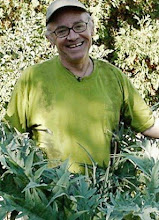 Love those Wolf River apples
Love those Wolf River apples And people question me when I say that I bag all my apples
And people question me when I say that I bag all my apples Transplanted carrots - but they still taste good
Transplanted carrots - but they still taste good The Cold Frame Manual - I am proud of my part in this publication
The Cold Frame Manual - I am proud of my part in this publication My light space in the basement
My light space in the basement Mylar is great reflective material - easy to get and use
Mylar is great reflective material - easy to get and use Some of the dry apples from this year's harvest
Some of the dry apples from this year's harvestThis has been a very rainy week. The sun shone on Saturday but for the most part the week was very wet. That was good for the winter rye planted last Sunday and for the lettuce and spinach seed planted then too, but not for any work in the garden or yard. I left the cold frame lids open for natural watering of the newly planted seed but had to close them after I decided that multiple days of rain was a bit too much for the seeds in the cool soil.
I harvested some of the carrots that were transplanted as seedlings and, yes, they did grow, but many of them have multiple root tips which is not ideal for carrots. The experiment worked but the multiple tips make cleaning a chore. Luckily there is no difference in the taste. I think I would like to experiment with deeper containers next season. Transplanting allows me to get my carrots in the garden in short rows and in multiple places and not have to struggle to get the seed to germinate which has usually been a problem in the past.
I checked today and the winter rye has begun to germinate, so by next week, I should see the shoots emerge from the ground. Also, I hope to be able to cover the hoop house with plastic this week. The forecast is not looking that good with more precipitation in store most of the week.
Once the hoop house is covered and when the spinach germinates, I will have to keep the soil moist till freeze up, when the seedlings will be on there own through the winter. I did occasionally toss snow inside on top of the spinach and the pictures back in earlier blog entries show what a great crop of greens we had in that space this season - so I hope to repeat the success.
I was pleased this week to receive copies of a publication that I wrote for the GOT DIRT program last year. The COLD FRAME MANUAL published for the GOT DIRT Garden Initiative was a excellent experience. Funded by the UW-School of Medicine and Public Health's Wisconsin Partnership Program in conjunction with UW Extension, the manual is available from the Brown County Extension office and is on line at this web site: http://www.co.brown.wi.us/i_brown/d/uw_extension/cold_frame_manual.pdf or you can Google search 'Cold Frame Manual and David Parsons'. The manual gives directions for making what I think is the best garden tools one can have; a set of cold frames.
I have been bringing in what few plants I intend to over-winter into the basement. There, I have a set of fluorescent lights and trays that are my winter green space now that I don't heat the greenhouse. The lights, boot trays, and space blanket Mylar material make a cozy bright area. I have about a dozen florescent tubes that are on a timer for 16 hours a day. Now there are three geranium plants (a variety called Robin Hood miniature that I have had for maybe 20 years!) that will be my source for cuttings next spring and a few orchids, one bay plant, and later space for other forced plants. Also, florescent lighting is one of the best ways to grow African violets. They seem to love the light culture and make fantastic blooms in this environment - just ask the violet growers in your area. There is more than enough light for my orchids and geraniums and thiswill be my indoor green space for the next several months.
Happy Gardening



































